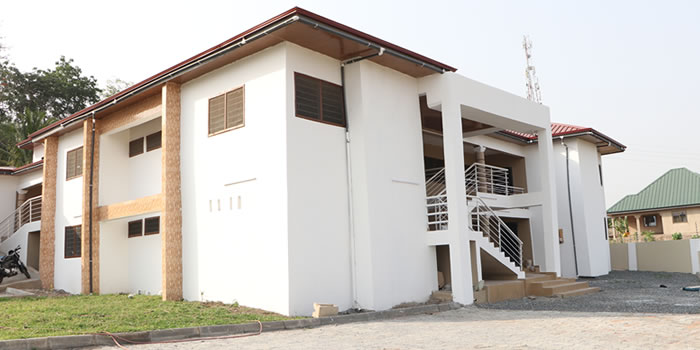

POPULATION
Population size and distribution
According to the 2010 Population and Housing Census, the projected total population of the District for 2017 is 47, 335 with males constituting 49.06 percent whilst females form the remaining 50.94 percent. The population of the District constitutes 1.9 percent of the regional population. The District is peri-urban in nature.
Age-sex structure Age and sex are the most basic characteristics of a population. Age-Sex Structure indicates the number of males and females grouped in 5 years age cohort. Table 2.1 reveals that male population is slightly higher than that of the female population from age 0-4 years through to 15- 19 years and then reverses in favour of females from age 20-24 years onwards. The proportion of population aged 0-14 years constitute 36.4 percent while population aged 15-64 years is 53.4 percent and that of those aged 65 years and older is 10.2 percent.
The relatively high youthful population (15-39 years) of 32.7 percent of the District has an inbuilt momentum for rapid population growth. This has profound implications for development and quality of life for the people of the District.
There is relatively high dependency ratio of 87.2 in the District compared to the regional figure of 81.3.
The age structure of the population in the District consists of a broad base made up of a large number of children and a small number of elderly persons at the top. With increasing age, the age-sex structure looks slightly thinner for the males than for females, indicating that the proportion of males reduces than that of females as the age increases. As depicted in Figure 2.1, there is high proportion of the population aged 0-4 years (12.8%) and 5-9 years (11.8%) which indicates that the population in the District has a potential to grow for a considerable number of years. Also the broad base nature of the population clearly indicates that, there is a heavy concentration of the population in the younger ages (below 15 years). This structure of population poses a challenge of high dependency ratio which usually leads to low savings and poor living standards.
Figure: 1.4: Showing population pyramid of the District
Fertility
Fertility for the purposes of this report means the total number of live births that females 15 years and older ever had during their lifetime. Measurement of fertility are important in determining the size and structure of the population and therefore critical for the management of the population for social and economic development. The commonly used measures of fertility are the Total Fertility Rate (which means the number of children a woman would have by the end of her childbearing years if she were to experience the currently observed age-specific fertility rates) and its component, Age-specific Fertility Rate (which also means the number of children a woman within a specific age group would have for the main purpose of knowing differences in fertility behaviour in each age group). The Crude Birth Rate indicates the number of live births per 1,000 population in a given year.
The Table indicates a total fertility rate of 3.3 children per woman aged 15-49 which is slightly lower than the Regional average of (3.4 children per woman). This implies that a woman living in the District would have an average of 3.3 children by the end of her reproductive period if the age-specific fertility rates were observed. Crude birth rate for the District stands at 21.7 children per 1000 population, which is also lower than the regional figure (24.6 children per 1000 population).
Comparatively, the North Dayi District has a lower fertility rate of 3.3 and crude death rate of 21.7 than Krachi Nchumuru which has a fertility rate of 3.8 and crude death rate of 25.1. The table further reveals that, the District has a higher fertility rate and crude death rate when compared to District like Ho Municipal and North Tongu.
Table 2.0 presents information on the number of children ever born to female population 12 years and older and children surviving. From Table 2.5, the District has 15,502 females with children ever born being 50,090 indicating that there are three children to every female (12 years and older). The number of children ever born increases progressively from 11 children (for women aged 12-14 years) to 5,227 children (for women aged 50-54 years) and starts to decline for women aged 55 years and older. Also children ever born to women aged 60years and above is 39.2 percent which is the highest whereas children ever born to women aged 12-14 years constitute 0.0 percent which is the least.
Moreover, women aged between 25-29years have 93.5 percent of their children surviving while those aged 60years and above have the least percentage of 78.6 of their children surviving. Women aged 25-9 years have 52.4 percent (the highest) of their surviving children to be males whilst women aged 60years and above have 48.3 percent (the highest) of their surviving children to be males being the least. Alternatively, women aged 60years and above have 51.7 percent of their surviving children been females whilst those aged 25-29 years have 47.6 percent of their surviving children been females.
MIGRATION (IMMIGRATION AND EMIGRATION)
Migration (immigration and emigration) is not very prominent in the District. This could be attributed to the fact that about 60% of the total populations are farmers and fishermen who have access to fertile lands for farming and the Volta Lake for fishing serve as source of income.
GENDER EQUALITY
Women Empowerment: Current statistics indicates that women in Ghana form above 57% of the total population and their roles have mainly been defined and shaped along biological and cultural lines. It is generally observed that women continue to face considerable constraints that prevent them from taking full advantage of opportunities that are available to them. Women generally have limited access to and control over Land credit skill and training education and decision making structure at both community and national level. Recognizing that Ghana is a signatory to the major international conventions that affect women and children, the District is committed to advancing their right and improving their status and ensuring that gender issue are treated among the cross cutting issues.
For this purpose, the pursuit of equitable participation in power and decision making for women as well as men will be recognized as critical to achieve development. Women and vulnerable participation in local governance has been encouraging.
The major limitation however is that most qualified women are unwilling to take up political positions and there will be the need to develop strategies to conscientize and promote their active involvement in public decision making.
There are about thirteen (13) women groups engaged in various fields of human endeavour in the North Dayi District. These groups have been receiving support from the Ministry of Gender and Social Protection and various other funding sources including MASLOC. The groups are involved in baking, fish smoking and processing, palm oil and gari processing, vegetable production and trading among others.
The aim is to empower women in the District to be economically self-supporting through engagement in income generating activities which would encourage them to be more readily responsive and confidently participate in the social, economic and political playing field in the District. This is expected to lead to the social and economic well-being of women and for the total development of the district.
SETTLEMENT SYSTEMS
Rural/Urban Split
The rural/urban classification of localities is population based. This means that a settlement with a population size of 5000 or more is classified as urban and settlement with less than 5000 people is considered rural. Based on this classification, North Dayi District can be considered as a rural district.
There are about sixty (60) communities which make up the district. The urban-rural population distribution is highly skewed to the rural areas as shown in the table below.
From table 2.3 above, all the over 60 communities in the District can be considered as rural since they have population of less than 5000 people. There are twelve (12) settlements with population between 501 and 4999 constituting 12 percent of the total number of communities in the District. This shows that there are few communities with high population concentration and this have implications for project design and resource allocation. Most of the settlements that fall in this category are located along the major trunk road creating a linear development pattern. Moreover, settlements with population of less than 500 represent 80% of the total number of communities in the district. This shows that majority of the communities are sparsely populated and therefore may create problems in resource allocation especially since most service can only be provided when such communities population meet the service threshold. The implication here is that in many cases where the community may not be able to meet the service threshold, the provision of some facilities necessitated by some compelling exigencies, may result into under-utilization or complete denial.
Spatial Analysis (Hierarchy of Settlements) The distribution of settlements in the district is dictated by some physical and economic factors including accessibility to socio-economic infrastructure and natural resource endowment. The hierarchy of services and infrastructure are interrelated to the growth and size of settlements. The bigger settlements tend to develop along the trunk road that traverses the district.
Naturally the size of a settlement tends to determine the level of services and infrastructure available. This is equally characteristic of the district with some exception. A careful analysis of the scalogram (functional matrix) of the district suggests that some settlements with population lower than others perform higher functions. Using data available to define the functional matrix of the district make Anfoega and Vakpo the only settlements in the district performing the highest level of functions. There is high concentration of social and economic infrastructure such as hospital, post offices, police station and hig her education service facilities available in the first level function in the hierarchy of settlements.
Apart from Anfoega and Vakpo, three other settlements are classified under the second level function. The next functional level includes settlements such as Aveme Beme, Awate Todzi, and Wusuta. These settlements tend to be located closer to the second functional level settlements. The majority of the people in this third level of settlement are mainly peasant farmers with low level of commercial activities.
The other functional level classified as the fourth level performs the least function with lower concentration of socio-economic infrastructure. Most of the people at this level are also peasant farmers and situated far away from important social services. The further away a community is to social and economic facility the greater the poverty level.
From the analysis therefore, it is evident that apart from settlements along the trunk road, almost all other settlements have low accessibility to higher level of services. The most affected settlement fall within the third and fourth functional level.
Table 2.4 shows the scalogram of the District.
Date Created : 11/23/2017 5:50:11 AM












 facebook
facebook
 twitter
twitter
 Youtube
Youtube
 +233 593 831 280
+233 593 831 280 0800 430 430
0800 430 430 GPS: GE-231-4383
GPS: GE-231-4383 info@ghanadistricts.com
info@ghanadistricts.com Box GP1044, Accra, Ghana
Box GP1044, Accra, Ghana